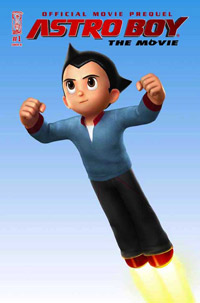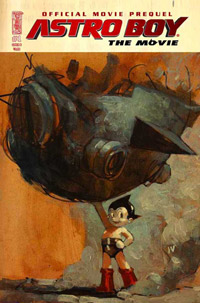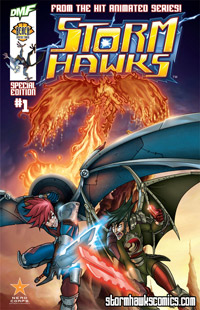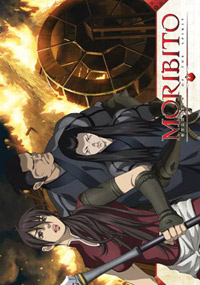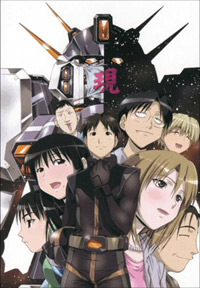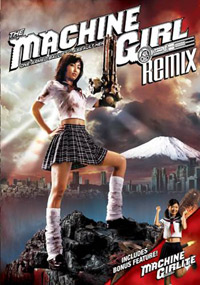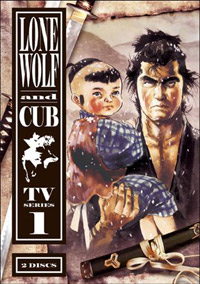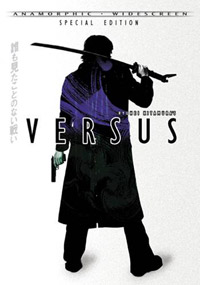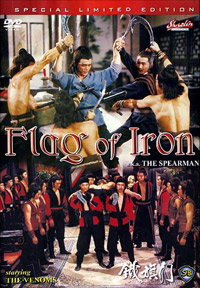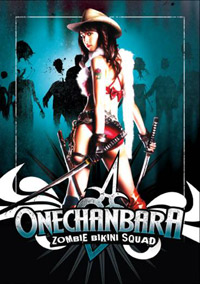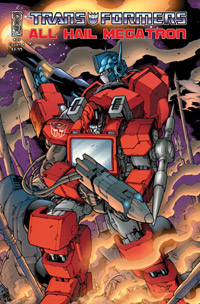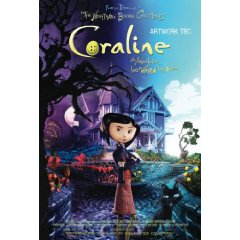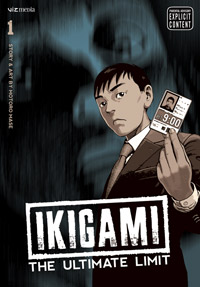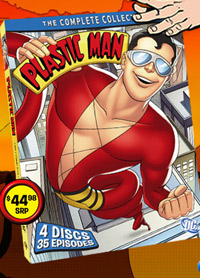 Logo handmade by Bannister
Column by Scott Green
Logo handmade by Bannister
Column by Scott Green
Astro Boy (2009) Impressions
AICN Anime has been fortunate enough to pick up an oldschool "spy" response to Imagi's CG Astro Boy. Thanks to the valiant "Boba Fat" we know the following about the movie:
The other day I got a peek at five scenes from the Astro Boy movie. Now, I know of the character, but that's about it. I don't know the story, history or how loved this character is amongst fans of manga / anime, but I'm guessing it's a lot as he seem to have been around for a long, long time. Anyway, the scenes I saw were his birth, Astro Boy discovering his powers, escaping from some sort of robot hunters, meeting a bunch of kids who live with a Fagin like robot repairer and a big fight sequence. The first thing that struck me was that the voice cast is full of heavy hitters, Nic Cage, Bill Nighy and Donald Sutherland leapt out, but a check of IMDB reveals Nathan Lane, Eugene Levy and Matt Lucas also, so, no complaints there. The look of the film, especially the city, is retro-futuristic, reminded me of Meet The Robinson's, though I don't know how faithful that is to the original Manga. The discovering his powers scene is pretty cool and full of gags, albeit the kind of jokes Richard Lester chopped into Supeman 2, but it had my four year old daughter laughing. I think there are parallels between Supes and Astro Boy and hopefully the movie plays on that more. The powers sequence ends with the burrowing and blasting out of Mt Fuji that is shown in the trailer. The camera on this stuff was pretty restrained and leaning more towards a traditional animation style rather than computer animation acrobatics and I definitely like that. The Robot hunters drive a big ship, clearly hate robots and are surprisingly brutal to the little fella, but the stand out scene, and parts of this was still animatics and storyboards, is a fight between Astro Boy and the robot hunters, in their giant king kongesque robot, amongst the skyscrapers. I'm a Godzilla geek so this pushed all the right buttons for me and the reveal of the robot is a pretty nifty trick that I won't spoil here. All in all it looks OK. I'm officially curious. It will be interesting to see how the fans react to this, but from what I can tell, the filmmakers, (it's directed by Davis Bowers who was also responsible for Flushed Away, but let's not hold that against him) have tried to treat the character and source material with respect.
Thanks again to "Boba Fat" for his preview of what's to come.
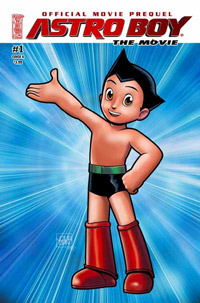
Comic Spotlight: Astro Boy Movie Prequel: Underground #1 written by Scott Tipton art by Diego Jourdan covers by Jourdan and Ashley Wood Released by IDW Publishing
Astro Boy is the Zeus of manga and anime. He may have been preceded by Titans in both media, but the child robot would overthrow those forbearers and lay out the governing template. Frederik L. Schodt's The Astro Boy Essays quotes Tezuka in saying that the early 1950's marked a "manga renaissance" ushered in by a confluence of intellectual freedom and the establishment of manga as a mass medium. With audiences looking for something fresh, like a sci-fi story informed by western animation, raised by Tezuka's brilliant storytelling, Astro Boy took hold. With him came Tezuka's vision for manga, including a cinematic visual approach, an expansive reach in influences and a willingness to mix heavy and light themes. A decade later, when Tezuka established Mushi Productions to create an Astro Boy anime, he similarly laid out a creative and economic model for how televised anime would be produced. On October 23, 2009, North America will see a new incarnation of Astro Boy. This one is a CGI film, produced by relatively new player in the field Imagi Animation Studios (TMNT, Highlander: The Search for Vengeance). IDW's Astro Boy comic offers a prequel to that movie, and it appears to be written for the child who'll be in the theatre in October. Given it's simplicity and the youthful perspective of its lead, if you're an adult, looking at Astro Boy, you'll probably need some existing curiosity about the character to get excited about this incarnation. And, for those fans of Astro Boy creator Osamu Tezuka's work, I recommend regarding the comic the way you might a figurine, an illustration or some other, alternative interpretation of the character outside the main canon. (If you're interested in a thoughtful, mature take on Astro Boy, check out Naoki Urasawa's Pluto) The first quarter of "Underground" doesn't suggest that it is trying to rework the kind of story that Tezuka told in weekly installment of Shonen for the 32 page American comic standard . If you have a fascination with Astro Boy and his history, it is interesting to see the transformation effected by the change in format, the connection to the Imagi movie, and Scott Tipton and Diego Jourdan's approach to the character. As noted in previous reviews, I'm no authority on what comics or manga are appropriate for children, but I imagine that Scott Tipton and Diego Jourdan's Astro Boy should easily fit into the role of an early comic for young readers. Its large, bright panels seem to offer an easy introduction to sequential art. Generally, if I'm giving a comic to a new reader, I prefer it to have generally uniform panel layouts, with minimal exotic departures. Astro Boy is far from rigidly formalized, with panels within panels, diagonal splits, and forms from one panel breaking into others. However, the size of the images offset the irregular layouts such that I don't think that an inexperience comic reader will have trouble with Astro Boy.There are a few potential concerns regarding how suitable the book might be for young audiences. In particular, I'm inclined to think some of the IDW house ads, such as ones featuring Megatron brandishing Optimus Prime's severed head on a pike or a Terminator's robotic skull dominating a page, are not right for that set. It's not what you'll be seeing on a trailer ahead of an Astro Boy movie, nor am I sure I would have liked to see a metal skull leering at me from a comic when I was a youngster. On a more positive note, the Astro Boy comic follows the tradition laid out by Tezuka in which the character is constantly reacting to his experience. The humanity in the character is evident in how he heedlessly rushes into situations, but also in the wonder and excitement he expresses. As in how Tezuka established Astro Boy, he's a super boy and not a super man. It's endearing to note how his reactions, needs and innocence suggest those of a child, and I think this is something to which a younger reader can connect. Beyond that core of Astro Boy's nature, the manga hits Imagi/IDW interpretation. Imagi Astro Boy director David Bowers said of the movie "It is [the origin]. I love classic super-hero origin stories. I love Richard Donner's Superman. I wanted to produce a film about Astro Boy that would sort of live up to the legend of Astro Boy and do him proud." With the primary colors of Astro's red boots and green waste band, often against blue backgrounds, the comic captures the bold exhilaration of a super boy jetting through the sky, on his way to thump a giant monster. Color has an additional role in the comic. Presented in digital gradients, it has the look of CG animation. This puts the comic in line with the Imagi Astro Boy movie, but also with a prominent thread of animation running in theatres and TV. If the reader is accustomed or in favor of that look, the color style might ingratiate the comic. Apart from the merits of Tipton and Jourdan's Astro Boy, an Astro Boy fan is bound to wonder what the comic indicates about the upcoming Imagi movie. Astro Boy's origin as told by Tezuka... In 2003, Tobio was speeding down the street in his hover car, when he lost control and crash head long into a truck. The boy death launches his father into a disastrous psychological arc. In the midst of a fit of grief Dr Tenma is struck with an overwhelming impulse to create a robot in the image of Tobio. The mania stays with Tenma, who commits the resources of the Ministry of Science towards realizing his dangerous vision of an advanced robotic surrogate. The results are a robot boy whose "pleasure circuits" light up as he learns and spends time with his father/creator. "After a while Dr. Tenma's mental condition improved, and both he and Tobio seemed very happy. But Tenma realized he had made a terrible mistake in the design of his robot son. No matter how much time passed, Tobio did not grow." In response, Tenma casts out the "freak" "doll." Tobio is stripped of his clothes and sold to a circus where he is redubbed "Astro." However, at the circus, Astro is spotted by Professor Ochanomizu, who "realized 'Astro' was not an ordinary robot." Freeing Astro and promising to be 'like a father,' Ochanomizu teaches Astro to use his special abilities like flight, acute sense, and rear mounted machine guns. And so, "The robot once known as Tobio was reborn and his new name was Astro Boy". Now for the tea-leaf reading... Tipton and Jourdan's Astro Boy opens with Astro in his super hero mode, but instead of only being looked after by his adopted guardian Professor Ochanomizu (Dr Elefun here), Tenma is overseeing Astro's heroism as well. The comic also emphasizes the father/son bond between Astro and Tenma. While Astro refers to Tenma as "dad," Tenma refers to Astro as "my boy" or "my son." A number of departures from Tezuka's Astro Boy origin can be inferred from how the comic presents the relationship between Astro and Tenma. In the original, Tenma sought for Astro to replace his son, and as such, tried to raise him as a normal boy. The superheroic force for justice came under Ochanomizu/Elefun's guidance. Tezuka's Astro Boy featured a number of longer narratives that might run in its weekly anthology for months. However, there was little continuity between stories, and Astro was generally unburden by his origin or by previous adventures. In that post origin status quo, Tenma became a dark figure in the lore, who fit uncomfortably into a few of Astro's exploits. Attaching a fatherly Tenma fondly looking on Astro Boy's city saving activities at least alters the time line and his idea of Astro Boy's purpose. Speaking about Nicolas Cage's portrayal of Tenma, Doyers said "he plays Astro Boy's father and he's really funny in the role, but really serious, dark, and emotional at the same time." My speculation is that the Imagi movie's drama is going to relate to a falling out and a climactic reconciliation between Astro and Tenma. I'd bet against Tenma selling Astro to the circus, but I am foreseeing some blow-out between father and son. I suspect that the comic prequel will be largely self contained, so, it'll be a welcome surprise if it affirms or refutes this conjecture about the movie. Regardless, the Astro Boy comic should please young readers looking for something colorful and energetic and Astro Boy wonks looking for something to comb over.
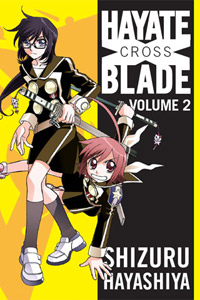
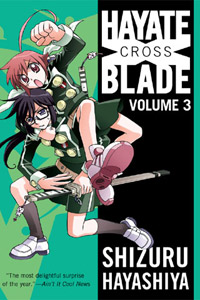
Manga Spotlight: Hayate x Blade Volumes 2 and 3 By Shizuru Hayashiya Released by Seven Seas/Tor
I'd admit to being guilty of directing my praise toward serious manga. Looking at my Twitter feed, it might seem like I can't shut up about Naoki Urasawa's melancholy Astro Boy reimagining Pluto and the like. Yet, the sales chart dominance of Naruto, Bleach, Rosario+Vampire and the like are testaments to the appeal of manga that connect quickly with vibrant characters and then use that anchor to build effervescent narratives. While it's been a while since I've been able to keep up with one of these as they pile into tens of volumes, I can certainly say that I do actually enjoy these energetic best seller. Yet, of that style of manga, one of the few that I enthusiastically track in anticipation is the obscure Hayate x Blade. If you looking for a plain fun manga, this criminally under read work receives my highest possible recommendation. If you like the Negimas and Fruits Baskets and One Pieces that dominate retail manga shelves, or if you don't like them, or if you've never heard of them, try Hayate x Blade. I'm confident that anyone with a sense of humor will find it to be a delightful discovery. At least in my case, the appeal of Hayate x Blade has almost nothing to do with its high concept. My adoration is instead owing to Shizuru Hayashiya's craft as a storyteller. Generally, when I'm effusive in my recommendation of manga, it's because that manga is important, highly distinctive, or otherwise "significant..." Town of Evening Calm, Country of Cherry Blossoms, which presented a look at Hiroshima a decade, then a generation after the atomic bomb was dropped... my favorite Osamu Tezuka works like Adolf or Phoenix: Karma. Then, there's a shelf below that of works that I enthusiastically advocate, but in a checked manner. For example, though I greatly admire and highly recommend it, I'll draw attention to the misgivings I have for Eden: It's an Endless World. Hayate x Blade fits into an unusual place in this scheme. By those benchmarks, it's nothing special, but it also flawlessly achieves its aims. It's a grafting of well established manga tropes. The shounen fighting tournament meets the prestigious all girls school. Hayate x Blade's publication history suggests the formula at work. It started off in Dengeki Daioh, where it was at home among works in which cute girls were a marquee attraction, such as Azumanga Daioh, Di Gi Charat, and Gunslinger Girl. Then, it moved to Ultra Jump, home to plenty of fight works, such as Battle Angel Alita: Last Order, Tenjo Tenge and Bastard. Teams of two sword wielding girls battle it out in a ranked, rule defined competition. Like many of the classic shounen leads, the Hayate of the title is a concentrated bundle of infectious enthusiasm, corralling in the reader with her single minded dedication to the manga's focal endeavor. The battle field and governing body for this melee is Tenchi Academy, a powerful institution that is home to all of the sororal affection, riverward and, in some cases, possibly romance, that would take a considerable diagram to map out. With Revolutionary Girl Utena preceding Hayate x Blade, even the hybridization of the type of school and the structured fighting isn't new to anime/manga fans. In an interview with Carl Horn, manga legend Kazuo Koike expressed his philosophy of character driven manga. Well, I've only been teaching how to develop characters-never how to construct a storyline. What I always try to do is persuade my students to create a strong character first. If you have a strong character, the storyline will develop naturally, on its own. The storyline then follows in the character's wake, and swirls around the character, influencing the character further...Strong manga can only be made when you create a strong character. In the case of Hayate x Blade, core characters are the id and ego, tsukkomi and boke, Burns and Allen pair of Hayate Kurogane and Ayana Mudo. The former is a half sized dervish whose ADHD is only curbed by the need to raise money to save the facility that raised her from yakuza lone sharks. The latter is a supremely competent, grouch/rage-a-holic, given to chasing off unwelcome bothers with a nail-studded baseball bat. Hayashiya immediately makes these characters distinctive through her illustration. Volume two opens with a post match moment. Hayate looks like a child making a scene, over dramatically pantomiming being worn out. Her eyes shut tightly. Her limbs are locked at right angles. An exasperated Ayana glairs from behind her thick glasses as she drops a criticism of Hayates lack of physical fitness. Hayate compresses down to the ground and begins rubbing on Ayana's shin and hamstring, where upon the senior partner begins shivering in pain. In its dynamic expressiveness, the exchange exemplifies what won me over in Hayate x Blade. I can think of a number of manga creators who I believe excel at character based sight humor. Rumiko Takahashi (Ranma 1/2, Inu Yasha) is in the forefront of that list. What Takahashi does is introduce the strong, apparent personality, then convey the joke through the illustrated form of the characters and the composition of the manga's page. See the gag on this page. Your attention is drawn to female Ranma as her figure breaks the panels, then Bang! table on the head, with the demeanor of the witnesses conveyed by their body language selling the joke. In contrast, Hayate x Blade approaches storytelling one panel at a time rather than through transition and page composition; and while the body is important, the face is given primacy. Personalities are always projecting, with each character in each panel playing to the back row with their expressiveness. Any time you see any character, they're selling themselves. In this way, Hayate x Blade is immediately fun to look at and that vitality never subsides. The fun extends to what to what Hayashiya is doing with her manga. There is a danger of a girls school manga that runs in a male targeted publication pandering to the audience. See Peach-Pit's DearS for a female created manga that acutely runs afoul of this. Rather than bending the manga to give the audience what it wants, Hayate x Blade reappropriates notions from a wide body of media and makes them its own. Many of the concepts are very Japanese. When there's an eerie girl with long tangles of oily black hair, anyone aware of the Ring should know the reference. When the manga makes reference to manzai comedy or feudal bonds between families, the full significance might require some active attention to ascertain. (Though in my mind, Higurashi - When They Cry illustrated that the premise of a work can be extremely Japanese without alienating North American anime/manga fans.) Yet, Hayate x Blades forceful commandeering of the tropes that it tackles is thorough enough that an American reader will be able to pick up the expectations with which the manga is playing. It's not so much deconstructing ideas as it is taking possession of them. The second volume's first story features the above mention kaiden creepy "dead wet girl," along with other legitimately laugh out loud funny tributary jokes such as the one that climaxes with the chambara sword fighting equivalent of Jackie Chan's final attack in The Fearless Hyena. The focal antic follows from a girl's fight to protect a wanna-be star, childhood friend who is under the sway of an abusive partner. This gag heavily leverages the comedian/straighperson format of manzai comedy. The manga and its translation are sufficiently clear that you don't have to be as familiar with beats of manzai as you might be a SNL sketch to pick up how the punch line twists expectation in a delightfully demented fashion.
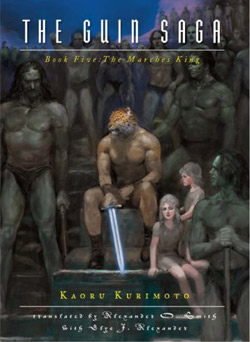
Prose Spotlight:Guin Saga Book Five: The Marches King by Kaoru Kurimoto Released by Vertical
I've been accused of over-promoting Guin Saga in these columns...I will admit that I have made an effort to prominently foist it upon AICN Anime readers. You'll have to trust me on this one. It's for your own good. Honestly people, if you follow Ain't It Cool News, Guin Saga's leopard roar of swords and sorcery pulp should excite fondness for the genre. Kaoru Kurimoto's work offers the ideal pacing and intelligence for an adult who no longer has the patience to slog through another nThe generation Tolkein derivative doorstop. A novel like The Marshes King is an afternoon's read, offering a clenched teeth yarn of protagonists and antagonists with no option but to fight their way through the opposing force. Kurimoto manages to weave together just about everything you could want from epic fantasy, with the sizzling immediacy of Japanese pop media rather than the tedium which sometimes weigh down the genre. The March King finds leopard masked warrior Guin on a literally god blasted landscape, trying to enlist Saga's equivalent of Wookies to aid its not-so-cuddly equivalent of Ewoks in fighting off an imperial expedition into the frontier wastelands. A brutal, unheroic ploy on the side of the protagonists has removed the stabilizing personality from the Mongauli army senior officers. At the same time, the savage monkey-men tribes of the Sem are on the verge of disarray and possibly interpreting Guin's absence as abandonment. Consequently, the Sem are at the verge of slaughtering the royal orphans that had been under Guin's protection. You couldn't ask for a more volatile situation. Guin is the demi-god catalyst in this formula. In the parlance of video games, the character is pretty much broken. Physically, he's Neo or Captain Blood; the demon on the battle field; able to take out named enemies and faceless soldiers on mass. Mentally, he's a gifted commander; Horatio Hornblower without the doubt or Richard Sharpe without the rough upbringing. Morally, he's Captain America, or some sort of Platonic ideal. "He might be surrounded by enemies, and plunged into what was, by any reckoning, an entirely hopeless situation, but he had no intention of giving up and leaving his fate in the hands of the gods, for that was the coward's way. If there came a day when the twins of Parros breathed their last, all the tribes of the Sem slaughtered down to the last brave warrior and a sword thrust through his own neck, that, and not a moment sooner - would be the day Guin stopped fighting." What gives Guin Saga its smart sense of danger is that you have this bold paragon of legends wading, sword in hand, into a desperate mess. In the Marches Episode that entanglement is the classic story with modern resonance of the army force that forces its way into a supposedly unprepared hostile territory. From a current view of the world, it could be thought of as poignantly reminiscent of Iraq or Afghanistan, but I'm reminded of an unsentimental notion George MacDonald Fraser put into the mouth of his scoundrel of historic fiction in the novel Flashman and the Redskins. In his old age, the British adventurer Brigadier-General Sir Harry Paget Flashman VC KCB KCIE thought back on dealing with the Apache in 1849. Decades after the tribe ceased to be a threat to western expansion, political correctness began to set in, galling the man who almost met with a nasty fate at the hands of Mangas Coloradas. Without excusing what was done by the United States or the Native Americans, Flashman explained the situation as he saw it. If you have two peoples with diametrically opposed ways of life, both entirely certain that theirs is the correct path; if these people are alone, face to face in an expanse of land that both need in order to realize that way of life, terrible things are bound to happen. "Guin had always suspected there was some reason that Mongaul had turned its eyes towards Nospherus. Perhaps it was, ultimately, to open trade routes - and perhaps the Mongauli were already too late. It would have been only one of their many miscalculations. A force of fifteen thousand men must have seemed a more than sufficient number to crush what little resistance the desert monkeys and barbarous giants, mindless yidoh, and vile sand leeches could offer. To an elite army, the wasteland no doubt had appeared to promise an easy conquest with scarcely the need to bloody a blade. Obviously the Mongauli didn't know the Nospherus" The enemies in this segment of Guin Saga are an expeditionary force sent by a martial society that keeps an iron grip on its domain because that rigidity is needed to keep their holdings from being snatched away. Lead by a talented but naive young noblewoman whose aims exceed her unseasoned abilities, this army conscripted from the duchy's lower classes has been beset by brutal conditions, man devouring wild life, and tribes of ape men willing to wage a scorched earth guerilla campaign against the invaders. It's not that the reader is encouraged to support these characters, but when rigid discipline breaks down and the soldiers begin committing atrocities worthy of Blood Meridian, the path to madness is visible and not just an excuse for righteous retribution on the side of the heroes. In the introduction to The Coming of Conan, Patrice Louinet presented a case for collecting Robert E. Howard's Conan stories in the order of publication rather than chronologically, with the inter-story inconsistencies found in their original form. Louinet noted that Howard described how he felt he was recounting tales of the barbarian's life as Conan himself might weave them, recalling the various adventures of his life. Guin Saga is reminiscent of Conan for a number of reasons. Both feature a gifted warrior who is known to have ascended to a throne through his Übermensch physical and mental superiority. Both concern themselves with the clash of peoples: nation against nation, formal army against guerilla warfare. Both feature names that evoke real world cultures and legends. And, both hearken back to epics, in which it was the story teller as much as the content that enthralled the audience. Guin Saga isn't character driven. It opens with Guin's painful rebirth into the world, which left much to mystery for both the character and the reader. Initially the character can't speak, eat or drink, but once he fully manifests himself, he's ready to meet the challenges of the world, with martial skills, wisdom, and actually, specific knowledge that puts him at an advantage in most situations short of being encircled by a squad of crossbow men or carried away by a sandstorm. Guin's manga descendant Guts from Berserk famously killed a hundred men, nearly shredding his own body in the process. As in that case, for Guin, there's a sense of limitations of muscle, flesh and sinew, but these realities are stretched to not quite super-heroic, not quite absurd extremes. The character is intriguing, but the reader is waiting for revelations to be presented and hopefully thrilling in his feats of hyper-competence, and not watching him develop. He might be a powerful current in the tide of events, but he's not the stream by which the novels flow. Nor is Guin Saga plot driven. Volume five opens with a quote from the in fiction history of the Saga's events, "The Chronicles of Cheironia" - "Guin, the leopard-headed warrior. When he appeared in the Roodwood he was but a wanderer, utterly alone. Now he had friends, the Lagon and the Sem." These are the words that end volume five as well. This has to be said to belong to the same school of secrecy in which the title of an episode of anime tells you that a given character is about to die. (Along the lines of the truth in advertising of Fushigi Yuugi's "To Die for the Star of Suzaku" rather than the hyperbole of Mazinkaiser's "Kouji Kabuto Dies in Magma!"). As such, the heft of Guin Saga is rarely, if ever, in a surprise turn of events. Instead of being character or plot driven, Guin Saga is a tale driven by authorial storytelling. For example, volume four ends with a decisive act that was in keeping with the nature of its perpetrator, that was forecast throughout the novel. Yet, the brutal way in which Kurimoto springs it on the reader and establishes what the act meant for those involved powerfully conveys its importance to the reader. She's a maestro at orchestrating elements that epic fantasies pull from as well as the components of her specific world. The story is deftly stage managed - shifting perspective, never lingering long enough to allow one to become boring - spotlighting characters, never letting any one seem strictly along for the ride. When she brings these movements to a crescendo, the impact is thunderous. Guin Saga's invading armies, furry creatures, orphaned royalty and amnesiac hero are all familiar elements of the genre, but Kurimoto writes passion and reality into the template. Nobody told these characters that they're simply archetypes or bit players. No idiot plots or featureless cogs robotically advance the story. If you look at Berserk, the manga that Guin Saga inspired, it's full of crowded battle fields in which creator Kentaro Miura renders each combatant as a specific person, fighting for their life. In Guin Saga, each soldier in the army of antagonists is a person who wants to fight their way through the conflict and safely return home to whatever enterprise they were engaged in before being conscripted. They're not simply there as strawmen for the heroes to topple. Then, the overlords who sent those men into battle have specific strategic and political aims. It becomes evident that the Marshes Episode concerns itself with a single spoke in a more complex world, and that this battle is happening to advance larger goals. As such, the army isn't simply there to provide the heroes something with which to contend. The fact that everyone involved is staking their lives on the action gives Guin Saga a potent vitality. AICN Anime's Guin Saga push is not entirely altruistic. Book five ends Guin Saga's "The Marches Episode," the opening campaign of about 4% of a novel series that's been running continually since 1979. The fact that Guin Saga recently spawned an anime series written by Shoji Yonemura (who adapted Berserk and Death Note for anime), with music by Final Fantasy's Nobuo Uematsu suggests that Guin Saga's Japanese popularity is in little danger of abating. As plans currently stand, Vertical has halted their release of Guin Saga at the conclusion of this Marshes story arc. Personally, I'd love to see Guin Saga pick up the momentum needed for Vertical to continue translating the series. In those words, buy Guin Saga! You'll be entertained, and I might be able to read more of these brilliant novels.
In the Law
In an editorial on the Editorial: The Handley case and the slippery slope MangaBlog points to ComiPress offers a comprehensive history by Lawrence A. Stanley and reports that Christopher Handley will plead guilty in the obscenity case against him, in which the manga collector was charged for receiving a package of manga from Japan. More commentary from Simon Jones Anime Vice
Signs of Live on Live Action Projects
Neb's Blog reported from the Anime Central convention During the opening ceremonies when ADV head Matt Greenfield was introduced, someone in the crowd shouted a question about if we'll ever see the long-promised live-action Neon Genesis Evangelion movie. "Soon, & I'm not kidding" was Mr. Greenfield's response. He clarified a bit later that evening during an Evangelion panel, saying the closer he gets to sealing the deal the less he can say anything about it. & the fact that he can't say anything at all anymore should be a clear sign to us how close the deal really is. He seemed pretty confident.* According to Hollywood Reporter, there been progress on the live action adaption of girls in power armor anime Bubblegum Crisis. The $30 million English language picture will take advantage of Singapore-Australia, Australia-Canada, Canada-Singapore, China-Australia and China-Canada co-production treaties. Principal photography will be carried out in Australia, with postproduction in Canada by Mokko Studio. Director and cast have yet to be decided. The spokesman said that "Crisis" will feature two male leads and a quartet of female leads -- two Caucasian and two Asian.* LiveActionAnime.org reports The Last Airbender producer Frank Marshall has announced that Academy Award-nominated composer James Newton Howard (The Dark Knight, I Am Legend and Peter Jackson’s King Kong) recorded the score for the movie’s teaser trailer.
Upcoming in Japan
Previews Magical Girl Lyrical Nanoha The MOVIE 1st Maiden Rose Boys Kamui Gaiden (live action adaptation of manga) My Coffee Samurai: My Boyfriend is a Vending Machine Anime One Piece creator Eiichiro Oda announced that he will be overseeing production of the 10th One Piece movie, "Strong World." The pirate manga's creator produced 120 design illustrations and an original story for the upcoming movie. via Anime News Network Historical fantasy television series The Legend (Tae Wang Sa Shin Gi/Tai O Shi Jin Ki) will be remade into an animated series, produced by a joint Korean-Japanese venture. Frequent Ghibli collaberator Joe Hisaishi produced the music for the original series, while Rose of Versailles creator Riyoko Ikeda drew the manga adaptation. The Yatterman revial will continue with anime movie Gekijouban Yatterman: Shin Yattermecha Osu gou! Omocha no Kuni de Dai Ketsudan da Koron, scheduled to hit Japanese theatres on August 22. Manga Inio Asano (Solanin) will launcher new manga Onna no Ko (Girls of the Beach) in the issue of Manga Erotics F due to hit stores in July Yuki Yoshihara (Butterfly, Flowers) will launched new shoujo manga Venus ni Arazu in the July issue of Petit Comic
New and Upcoming in North America
ADV Films ADVNation notes that ADV Films Media Coordinator, Janice Williams stated that audio issues will be fixed in the company's re-release of the 2004 Appleseed "...Many have noticed that the sound effects lacks punch with poor dynamic range and bass, almost as if its been dynamically compressed. The musical score, on the other hand, is mixed too loudly often overpowering the sound effects, especially on the Japanese tracks. The DTS track sounds too rear heavy and front light, very light..." Bandai Entertainment The Robert's Anime Corner Store Blog reports Bandai Entertainment has indefinitely delayed the Kurokami The Animation Part #1 DVD Bundle (Disc #1&2) and Freedom (Freedom Project) Complete Collection DVD Boxed Set. "To demonstrate that these really are 'TBA' and will probably not be rescheduled before this fall, Bandai has canceled all existing retailer pre-orders and we will have to reorder them once they eventually get re-solicited (assuming they do)." Dark Horse Posted by Blade of the Immortal editor Philip Simon on Dark Horse's forum Hello, friends -- I've been deep, deep in the trenches lately. (EDEN 12 is a mind-blower!) Our BLADE OF THE IMMORTAL novel will have new color cover art, 6 new pencil illustrations, and a belly-band image that's fairly small, so it'll probably fit perfectly on the back cover -- everything that's found in the Japanese edition!! More BLADE news on the horizon -- stay tuned!! Dentsu ICV2 reports that Dentsu will be launching the Mameshiba bean-dog characters in the U.S. this year, and is looking for licensees in the plush, toy, fashion, accessory, and collectible categories. Animated Mameshiba feature 25 puppy-faced bean characters paired with trivia. DMF Comics and Beach Creative Studios Starting this summer DMF Comics and Beach Creative Studios will be launching the first issue in a line of Storm Hawks full color graphic novels. The series will kick off with a Special Edition Comic Book premiering at Vancouver Anime Evolution in June, and will make the rounds at comic and anime conventions across North America through out the summer. Comic Book stores will then get the chance to order the Storm Hawks Special Edition #1 in July. Shipping date will be in September. Storm Hawks has been seen in Canada through YTV and in the US through Cartoon Network. It first aired in 2007 and is currently in it’s second season. The Special Edition Comic Book will feature three Storm Hawks stories and an all star gallery of pin-ups from some of the best talent in the animation and comic book industry. Featuring Mike Kunkel (Hero Bear and the Kid), Sean ‘Cheeks’ Galloway (Spectacular Spider Man), Marcio Takara (The Incredibles), Sanford Greene (Marvel Adventures Spider-Man), Marcus To (Fathom), Randy Green (X-Men) and more.Media Blasters The release of Moribito 4 & Moribito Collection 2, Vol. 3&4 have been moved to 7/7/09 August releases include... Anime 8/4/09 SAMURAI DEEPER KYO LiteBox - Eps. 1-26 - 6 Discs - $49.99 MORIBITO: Guardian of the Spirit - Vol. 5 of 8 - Eps. 14-17 8/11/09 GRENADIER LiteBox - Volumes 1-3 - Eps 1-12 - 3 Discs - $29.99 8/18/09 AH MY BUDDHA: The Four Naked Truths - Volume 4 - Eps. 14-17 8/25/09 GENSHIKEN 2 Vol 1: Full Circle - Eps. 1-4 Live Action 8/4/2009 MACHINE GIRL REMIX - Includes Machine Girl Lite - $24.99 8/11/2009 LONE WOLF AND CUB: Collection 1 - Volumes 1-3 - 6 Discs - $39.99 8/18/2009 VERSUS: Special Edition LiteBox - 3 discs - $34.99 8/25/2009 THE FLAG OF IRON ONECHAMBARA (Live Action) Manga 8/26/2009 DOJIN WORK - Pencil and Paper - Volume 4 of 4 Genshiken 2 The Society for the Study of Modern Visual Culture, otherwise known as Genshiken, is now under the charge of a more confident Sasahara. Things have changed in between semesters (for all the details, check out the bonus Genshiken OVAs included on the Kujibiki Unbalance TV series), and the otaku club now has a new otaku-hating member named Ogiue. Sasahara's initial goal of starting a dojin circle and selling those fan-made magazines at the next Comic Festival becomes a reality, but reality is a cruel master. Who apparently crossplays. Afterward, the club is abuzz with talk about Tanaka and Ohno's relationship, which takes a hesitant step forward. Grenadier During the time of the Great Japanese Civil War, the faithful samurai Yajiro Torajima finds himself surrounded by an enemy army. It is at that moment that the bountiful Rushuna appears to save him with an enchanting smile and high-calibur revolver. Rushuna's mission is crucial to mankind - she is traveling across Japan in search for a solution that will bring about an end to war forever. Together, Yajiro and Rushuna challenge countless opponents with his sword and her talent for reloading on the bounce. Samurai Deeper Kyo During the epic battle of Sekigahara, two samurai face off outside of history. The heated duel between Kyoshiro and Demon Eyes Kyo is interrupted when a falling star slams into the plains, shattering the ground and engulfing both of them. Years later, Kyoshiro, now a medicine man, wanders the land with a forgotten past. Hidden deep inside him is the soul of his old opponent, Kyo, slayer of a thousand men. When the bounty hunter Yuga and Kyoshiro are thrown into battle, the medicine man’s friendly personality retreats, and the world learns why Kyo is called a demon. Hachette Books The Sigh of Haruhi Suzumiya, the second light novel is the series, is scheduled to be released in October. A preview can be read here IDW IDW announced that it has extended Transformers: All Hail Megatron four issues.Starting in July, IDW will publish, under license from Hasbro, Inc., four monthly issues, each featuring two short stories that detail the aftermath of the 12-issue All Hail Megatron series. The short stories in Transformers: All Hail Megatron #13-16 feature a dynamic team of writers and artists, including Simon Furman, Shane McCarthy, Mike Costa, Andy Schmidt, Denton Tipton, Nick Roche, Zander Cannon, Guido Guidi, Chee, Emiliano Santalucia, Andrew Griffith, Casey Coller, and fan-favorite artist Don Figueroa. Plus, each issue will boast striking variant edition covers by eye-catching cover artist of the series, Trevor Hutchison. Transformers: All Hail Megatron #13 launches in July 2009. Transformers: All Hail Megatron #14 launches in August 2009. Right Stuf/ Nozomi Anime producer and distributor Right Stuf, Inc. and Nozomi Entertainment announced that the HIS AND HER CIRCUMSTANCES (Kare Kano) DVD Collection will be released on August 25, 2009. The 5 disc set will be retail for $39.99. This new, value-priced collection will feature the entire 26-epsisode series – with English and Japanese audio, English subtitles and on-screen translations, and Spanish subtitles and on-screen translations – in a single keepcase. Also known as “Kareshi Kanojo no Jijou” (or “Kare Kano”), this anime adaptation of Masami Tsuda’s fan-favorite manga is a production of GAINAX (Evangelion, Gurren Lagann) and features direction and a screenplay by Hideaki Anno (Evangelion, Gunbuster). The Kare Kano manga was serialized in Japan’s LaLa shoujo (girls’) comics anthology, from 1998 through 2005, alongside titles including Ouran High School Host Club, MeruPuri and Vampire Knight. It is published in North America by TOKYOPOP. Visit for more information about His and Her Circumstances and for the trailer, desktop wallpapers and more. About HIS AND HER CIRCUMSTANCES Like a drug, Yukino Miyazawa was addicted to admiration and praise from those around her. She worked hard to become the perfect student, the perfect girl. But that was before... him. Souichirou Arima. The instant she met him, she hated him. Without even trying, he snatched the very glory from her hands by easily acing the high school entrance exam that should have made her the class representative. To take back what is rightfully hers, Yukino is putting all her efforts into plotting her revenge; but was love part of the plan? © 1998 Masami Tsuda / Hakusensha / Gainax / Karekano-Dan / TV Tokyo / Medianet Universal The Blu-ray Blog has the 411 on the release of Corraline. Both 2D and 3D version will be on the disc (July 21, 2009, MSRP $39.98) (Package art Coming Soon) 2-D and 3-D Versions Included 4 Pairs of 3-D Glasses Included Video: 1.85:1 1080p VC-1 Audio: 5.1 DTS-HD Master Audio Special Features Include: Feature commentary with director Henry Selick and composer Bruno Coulais (on 2-D and 3-D versions) Deleted scenes The Making of ‘Coraline’ Voicing the Characters Creepy Coraline D-Box U-Control (on 2-D version only): Picture-in-picture Tours and voice sessions Animatic picture-in-picture BD Live: My Scenes Sharing The World According to Henry Digital copy of 2-D version (expires July 31, 2010) VIZ Media Anime News Network reports Viz will jump ahead in the Shonen Jump serialization of One Piece to the point at which the series is current running in Japan starting this fall. * VIZ Media has releases IKIGAMI: THE ULTIMATE LIMIT, which is rated ‘M’ for Mature Audiences and carries an MSRP of $12.99 US / $15.00 CAN. In a futuristic dystopian Japan there is new slant on crime deterrence with a sinister policy with an ironic twist. Each day a randomly-selected person is put to death to remind the population of the very value of life. Those who are condemned to die receive an official government notice the day before, called an ikigami, alerting them of impending doom in 24 hours . “Dear Citizen: You’ve no doubt noticed that the world is a troubled place. People are apathetic, lazy, unmotivated. You’ve probably asked yourself: Why isn’t anything being done to stop this systematic decline? Well, you’ll be happy to know that measures have been taken. We, your government, have decided society needs a wake-up call. So beginning today, we will randomly select a different citizen who will be killed within 24 hours of notification. We believe this will help remind all people how precious life is, and how important it is to be productive, active members of society… CONGRATULATIONS! YOU HAVE BEEN RANDOMLY SELECTED BY THE GOVERNMENT…TO DIE IN 24 HOURS!” IKIGAMI: THE ULTIMATE LIMIT originally debuted in Young Sunday and the manga has sold more than one million copies in Japan. Its popularity further inspired a live-action film that was released in 2008 in Japan starring the popular young actor, Shota Matsuda. Acclaimed artist and manga creator, Motoro Mase was also nominated for Shogakukan’s 43rd Grand Prize for best comic by a new artist.Warner Home Video The 35 episodes of the Plastic Man animated series will be released in a 4 DVD on September 1 for $44.98
The Business
Imagi International Holdings Limited (TMNT, the upcoming Astro Boy) today that Douglas E. Glen, Chief Executive Officer and Executive Director, has resigned his position. IMAGI and its Board of Directors have begun a search for Glen's permanent replacement. Meanwhile, the Company has appointed one of its Board members, William Courtauld, as Acting CEO. Glen joined Imagi in late 2006 and oversaw the Development of TMNT. William Courtauld has stated “Astro Boy has the makings of a smash hit, and we now have a strong pipeline of CG projects to follow it, including Gatchaman. Our studio employs many highly talented people, and IMAGI has the unique strategic advantage of having roots both in Hollywood and in Asia. Also, after a difficult period during the current economic downturn, we are now in sight of long-term financial stability. I look forward to handing over the reins to a winner who can make the most of these fabulous assets.”* Anime based figures maker Jun Planning suspected operations on April 30th ahead of a bankruptcy filing. The company, which had released figures in North American was 3.2 billion yen (about US$33 million) in debt.* A transcript of 4Kids' (Yu-Gi-Oh) first quarter earnings conference call can be read here. In the licensing segment first quarter of 2009 revenue remained constant approximately $5.6 million. This consistency between periods is primarily attributable to increased domestic licensing revenues from Monster Jam property of approximately $1.4 million substantially offset by decreased domestic licensing revenues attributable to the Yu-Gi-Oh and Shaman King properties of approximately $0.9 million and $0.4 million respectively. In the advertising media and broadcast segment, first quarter of 2009 revenue was approximately $0.8 million as compared to $3.6 million in ’08, a decrease of approximately $2.8 million. This decrease was the result of the CW’s $3 million minimum guaranteed share of revenue which was also against the company’s revenues from the sale of network advertising of the CW4Kids when compared to the same period in the prior year which Fox Broadcasting was amortized and classified as an expense, partially offset by increased revenue from the sale of internet advertising time on the company’s website.* Comic book publishing company eigoMANGA (http://www.eigomanga.com), announced a magazine subscription partnership with EBSCO. The agreement makes comic book subscription of their titles 'Rumble Pak' and 'Sakura Pakk' accessible worldwide to public schools, universities, hospitals, and military institutions.* Kodansha, Shogakukan, and Shueisha announced acquisition of 28.9% of Japanese book retailer Bookoff Corporation.* Cartoon Brew reports Canadian animation studio Fatkat has shut its doors. The studio employed 100 people at its peak providing service work on shows like Skunk Fu!, Chaotic, and SuperNormal.
Digital Distribution
FUNimation Entertainment, Toei Animation Co., Ltd., publisher Shueisha, Inc. and broadcaster Fuji Television Network, Inc. have entered into an agreement giving the American anime leader exclusive rights to the U.S. and Canadian online simulcast of the studios' signature animated series One Piece. Starting Saturday, May 30th at 9:00 p.m. CDT, one hour after airing in Japan, FUNimation and the consortium will stream the first, free, professionally-produced, accurately English-subtitled One Piece series episode beginning with episode 403 via the official One Piece website followed soon thereafter by FUNimation partner sites. Each new episode of the current season will be rolled out weekly as One Piece continues its Japanese television run. In addition, beginning Thursday, May 14th FUNimation will stream episodes from the Sabaody Archipelago Saga story arc starting with episode 391. FUNimation will also offer both its produced uncut, English-tracked and English-subtitled adaptations of the hugely successful series beginning with the first episode. "With digital technology drastically changing the media environment surrounding broadcasts, we've gained the understanding and cooperation of Shueisha, the publisher of the original manga, and Fuji Television, which broadcasts the show in Japan, the primary target audience. With help from FUNimation, our One Piece partner in North America, we've managed to make a One Piece simulcast a reality. With this simulcast, we'll be able to deliver a version of One Piece with much "fresher" excitement and greatness than ever before to even more viewers in the United States than ever before. It's incredibly exciting." Said Kanji Kazahaya, director of Toei Animation Co., Ltd. "This simulcast is a turning point for FUNimation, our One Piece partners and the U.S. anime industry," said Gen Fukunaga, president and CEO of FUNimation Entertainment. "Thanks to our close partnership with Toei, Shueisha and Fuji Television, together we have effectively closed the longstanding gap between the Japanese broadcast and U.S. distribution of a series. As One Piece continues to be one of the top rated anime still in production, we can assure U.S. fans that new episodes of One Piece will not only make the voyage overseas, but will do it virtually instantaneously."* Digital Manga Publishing, Inc. announced the revamp of its online rental and manga viewing site, eManga.com which streams content through an Adobe Flash player. Features include two-page, one-page, or panel-by-panel reading, three custom zoom options, a bookmark bar, and auto play, the reader is also made to work with different screen sizes to maintain image quality at any screen size. The relaunch includes previews of new titles such as Vampire Hunter D, Tricky Prince, and Steal Moon. The standard eManga rental package is $10 for 1000 points, with entire books averaging between 200 and 300 points. Higher packages come with free bonus points. Points are kept in user's accounts, allowing for quick and easy rental of titles whenever and wherever they want.* Crunchyroll's new live action content include Munhwa Broadcasting Corporation Korean drama 90 DAYS TIME TO LOVE, MERRY MARY, and MY LIFE'S GOLDEN AGE Title Synopses: 90 DAYS TIME TO LOVE There is a man whose life that will end in 90 days. Although he's already married, he wishes to find his true love and spend the rest of his remaining days with her. This woman will be the hall elder sister. Will they who are secretly in love commit incest within ninety days? This is a story about fate that surpasses taboo and a love that surpasses morality. Here, at the peak of his life at thirty-one years of age, is a man who is fated to vanish into space as a mere speck of dust in three short months. The fall of 2006, a man and a woman were fated to meet, but their hearts were destined to be broken in the end. They are now desperately pleading for 90 days in which to love each other for the last time on earth. If you were this man's wife, or this woman's husband, how would you answer their pleas that transgresses both morality and taboo...? MERRY MARY MERRY MARY introduces the main characters, Mary and Daegu, who will redefine the meaning of happiness. These are like the young people who live in your neighborhood...People who keep their chins up even though they are poor and live a tough life. She is a woman who is full of laughter! And he is a man who shines with happiness! You'll discover happiness when you begin sharing and joining them on this incredible story. MY LIFE'S GOLDEN AGE In order to bring about a hwang-geum-ki (golden period of life) in their children's lives, a remarried couple names their children uniquely: Lee Hwang, Lee Geum and Lee Ki. However, little do the parents know that there are many trials and tribulation before the golden period of life. Lee Hwang (Moon So-ri) is the smart, aloof one who works at a publishing company as a designer. Her life seems very much in control, with a seemingly loving husband and an adorable daughter, but there is more than meets the eye for her married life turns out to be anything but perfectŠ Lee Geum (Lee So-yeon) has two secrets: one, she's still paying the hospital bill for her birthfather and it's putting her heavily in debt; and two, she has CML (chronic myelogenous leukemia). Regardless, she's bright and cheerful as she coaches a track team. When she fatefully meets Ko Kyung-woo (Shin Seong-rok) and becomes tangled up in a contract marriage, things start spiraling out of controlŠ Lee Ki (Shin Yi-han) has a set life: he finished med school and is an intern at a hospital. But in order to live his true dream, he quits and starts training to become a musical actor. As he secretly attends dance lessons while pretending to still work at the hospital, he must deal with the troubles of his sisters as well as the fact that he just may be falling in love with his sister-in-lawŠ A family drama about the relationship between parent and child, brothers and sisters, romance, marriage, divorce, reconciliation, dreams and hope. New Kadokawa live action include The Beast To Die, Early Spring Story, Girl Of Time, Kekkon Annai Mystery, Sailor Suit And Machine Gun, Story Of The Detective And Tragedy Of W. THE BEAST TO DIE A cop was killed and his gun was stolen. It was used for the next murder case. Detective Kashiwagi who investigated this case got a testimony about a perpetrator; "He walks like a dead man". The detective found a guy named Date (Yusaku Matusda) who was an ex-Vietnam veteran cameraman descended into madness after committing a string of murders. Yusaku Matsuda lost 8 kg of body weight and allegedly even had some of his teeth pulled out in order to achieve the gaunt look for the murderer. EARLY SPRING STORY A university student Hitomi falls in love with a middle-aged man Okawa, who was the lover of her deceased mother. Hitomi's feelings shift back and forth as she is not sure whether it is true love or just a realization of her mother's romantic dream. GIRL OF TIME A romantic 16-year-old high school girl in love with a classmate starts dreaming about events before they actually happen. As it turns out, the object of her love is actually a space alien affected by her own romantic views of life and because of their unified wave length. KEKKON ANNAI MYSTERY A 19-year-old girl Hiroko Terasawa working in a matching agency promises her client Masakazu Sekine that she'll pose as his fiancee for a remarkable cash reward. Hiroko moves to Sekine's mansion and prepares to attend the family's meeting. However, this only turns out to be a prelude of a bloody fight over the family's legacy. SAILOR SUIT AND MACHINE GUN Following the unexpected death of her mob boss father, a young high school student (Hiroko Yakushimaru) inherits his Yakuza gang. They investigate her father's murder and take out the drug dealers who are responsible for his death. The scene of Hiroko when she sprays a room with machine gun fire and then exclaims "Kaikan!!" became somewhat famous in Japan at the time with people using the phrase in the same tone of voice as Hiroko. STORY OF THE DETECTIVE Naomi (Hiroko Yakushimaru) is a university student who is leaving in a week for the US to study; Shuichi (Yusaku Matsuda) is a washed-up gumshoe who's hired by Naomi's father to bodyguard his daughter until she leaves. Things got worse when Naomi and Shuichi stumble upon a murder. TRAGEDY OF W A young girl is striving for stardom. In order to get a lead role in a new production, she agrees to stand-in for a famous star whose rich patron died in her arms one night. The real-life drama gradually comes to mirror the story of the play being performed by her.* Dark Horse addresses their iPhone distribution i

